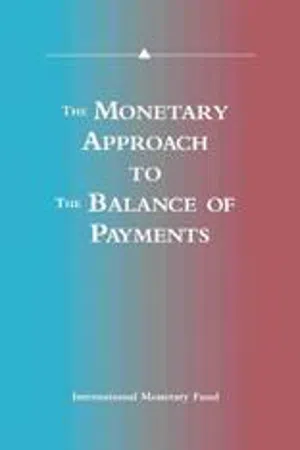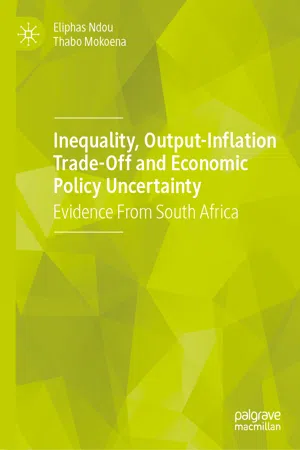Credit Channel
The credit channel refers to the mechanism through which changes in the availability and cost of credit impact economic activity. It focuses on how changes in the supply of credit by financial institutions can affect the behavior of borrowers and ultimately influence spending, investment, and overall economic performance. This concept is important for understanding the transmission of monetary policy and the functioning of financial markets.
8 Key excerpts on "Credit Channel"
- Ercan Özen, Simon Grima, Ercan Özen, Simon Grima(Authors)
- 2020(Publication Date)
- Emerald Publishing Limited(Publisher)
...The results manifest that interest channel directly affects direct fixed capital investment and RGDP. Interest channel was found to be effective on these variables of the analysis. In the second part, Toda–Yamamoto causality test was harnessed for SUE, YUFE and FO variables. Interest channel did not provide a result that affected YUFE and SUE. Keywords : Turkish economy; monetary policy; monetary transmission mechanism; interest channel; Zivot–Andrews unit root test; Toda–Yamamoto causality test JEL classification: E42; E52; E58 1. Introduction Finance and monetary policy are the two economy policies that complement each other. Finance policy refers to state-led formation of income and expenditure policies in alignment with specific objectives such as economic growth and development. Monetary policy relates to compilation of resolutions issued by central banks to meet specific economic goals via utilizing policy tools. Policy resolutions of central banks necessitate harnessing appropriate and effective policy tools in order to steer national economy. Transmission mechanism means monetary transfer from financial markets to real market as a result of resolutions on monetary policy. The way functioning of this mechanism can affect macroeconomic variables is vitally important. Therefore, it is mandatory that to reach their objectives authorities of money implement appropriate policy tools. Despite being a powerful tool, monetary policy may occasionally result in unexpected outcomes. Furthermore, to ensure success in the execution of monetary policy, it is a must to correctly analyze timing and effect of this policy on economy (Mishkin, 1995, p. 4). As regards national economies, there may be a divergence from state to state in the functioning of their monetary transmission mechanism. This divergence is bound to economic parameters such as financial structure of a state, index of openness and its role in global economy...
- International Monetary Fund(Author)
- 1977(Publication Date)
- INTERNATIONAL MONETARY FUND(Publisher)
...The implication of this is that the authorities, and therefore the banking system, can only determine the division of the supply of money between foreign and domestic assets through controls over domestic credit. T HE I MPLEMENTATION The channels through which the credit approach operates can be determined by examining the behavior of the different sectors in the economy. As the economy grows, an increase in the quantity of money demanded reflects the decision of the community to use part of its increasing income and wealth to add to its money holdings. This is a saving decision by which surplus sectors release real resources to accumulate claims on the banking system. These resources are channeled to those economic units whose expenditure exceeds their income. The deficit units borrow the savings of the surplus units through the banking system, which accepts their promise to pay in the future. Hence, the credit expansion of the banking system is tied to the availability of resources that the public is willing to save in the form of assets created by the banking system. Thus, the existence of a well-functioning banking system contributes to the separation of the saving and investing functions as reflected in the decision of the surplus sectors to hold money and of the deficit sectors to supply domestic assets. 17 The banking system, however, can extend credit in amounts different from those made available by the public. In this case, prices and the balance of payments will perform the necessary adjustments. Thus, in an open economy credit policies represent a method of managing aggregate demand and the balance of payments. Any attempt by the authorities to reduce or eliminate a deficit or to create or increase a surplus will require control of domestic credit, so that, on the one hand, resources can be released to expand exports and, on the other hand, imports can be reduced...
- eBook - ePub
Monetary Policy after the Great Recession
The Role of Interest Rates
- Arkadiusz Sieroń(Author)
- 2020(Publication Date)
- Routledge(Publisher)
...According to him, the seller of the bond will have more money, so she will want to spend it on other assets, which will raise their prices and make the remaining assets relatively cheaper. Over time, newly acquired money will spread across the economy, affecting the prices of ever more financial assets. The rise in their prices will, however, make nonfinancial assets relatively more attractive, which will encourage investors to buy them, transmitting the effects of monetary expansion into the real sector. 10 Although the literature lists several channels of monetary transmission, Chick (1973) argues that they all can be reduced, on a general level, to two basic views: the classical, revived later by the monetarists, and the Keynesian. 11 The former mechanism implies direct effects of monetary policy on spending, while the latter is supposed to work only indirectly, through the interest rate, which determines the cost of borrowing. The debate is somewhat futile, as both sides have a point. I mean that in the contemporary monetary system, new money enters the economy via the credit market, affecting the economy through interest rates in the first place. However, this is not a logical necessity, and the monetary expansion would affect the economy even without any changes in interest rates. 12 Anyway, there is little recognition in the Keynesian literature that monetary policy works through the supply schedules and prices of financial assets. In reality, economic agents react to changes in relative prices, adjusting their portfolios and thereby transmitting the monetary impulses to income and spending and the real sector. Nonetheless, the substitutability between money and financial assets is central in both the Keynesian and monetarist views (Cagan 1972)...
- eBook - ePub
Inequality, Output-Inflation Trade-Off and Economic Policy Uncertainty
Evidence From South Africa
- Eliphas Ndou, Thabo Mokoena(Authors)
- 2019(Publication Date)
- Palgrave Macmillan(Publisher)
...First, the chapter determines the direct effects of economic policy uncertainty shocks on credit growth dynamics. Second, it determines the role of economic policy uncertainty regimes in impacting the reaction of credit growth to expansionary monetary policy shocks. Third, the chapter determines the amplification effects of economic policy uncertainty in transmitting expansionary monetary policy shocks to credit growth. These last two issues are important in determining the size of the repo rate adjustments. In addition, the chapter shows that economic policy uncertainty regimes affect the ability of credit conditions index to transmit expansionary monetary policy shocks to credit growth. Figure 31.1 shows a theoretical depiction of the transmission mechanism of uncertainty shocks to credit dynamics via two channels, but this is not exhaustive of all the channels. The first channel shows that elevated macroeconomic uncertainty impacts the strategies of financial institutions’ lending decisions, the screening of customers, and the decisions on how best to allocate credit (Chi and Wi 2017). 2 Thus, heightened macroeconomic uncertainties make it difficult for lending institutions to allocate credit. In addition, due to the asymmetric information, banks may allocate scarce credit loans to those borrowers with poor prospects for future gains. As a result, increased information asymmetry can directly increase credit risks and raise the cost of debt, leading to reduced credit extension. 3 In the second channel, the elevated uncertainty shocks lead to increased financial frictions, a factor that raises the risk premium and reduces credit growth. Fig. 31.1 Theoretical depictions of elevated macroeconomic effects on credit dynamics (Source Authors’ calculations) Evidence reported in the literature points to the prolonged negative responses of output to positive policy uncertainty shocks...
- eBook - ePub
- Anthony J. Makin(Author)
- 2016(Publication Date)
- Routledge(Publisher)
...C H A P T E R 8 The central bank and monetary policy This chapter focuses on the role of money and the central bank in open economies. Central banks implement monetary policy by controlling the money supply to influence domestic interest rates and exchange rates and have considerable discretionary powers to conduct monetary policy independent of national governments. The increased independence of central banks arose from concerns that direct government manipulation of the money supply for political reasons led to higher inflation. Owing to financial deregulation and globalisation, the conduct of monetary policy has changed markedly over recent decades. In particular, there has been a worldwide shift away from credit rationing approaches, previously implemented via techniques to alter the quantity of funds that domestic commercial banks could lend, to more market-oriented approaches. In the past, debate about monetary policy has centred on the relative importance of its end goals – low inflation and low unemployment – and on the best means of achieving those goals. Central banks worldwide currently see inflation control as the main objective of monetary policy. In the short term, monetary policy affects real economic activity and hence employment via short-term interest rates and nominal exchange rates. In the long term, however, monetary policy only affects the domestic price level, and hence inflation and the exchange rate. In what follows, we examine the monetary system, inflation and the operation of monetary policy in the short and long run. The central bank and the monetary system Figure 8.1 depicts the typical structure of an economy’s financial and monetary system. This system is essentially a network of financial institutions, which, by and large, act as intermediaries, or go-betweens, for savers and investors in the economy...
- eBook - ePub
- Lorenzo Garbo, Dorene Isenberg, Nicholas Reksten(Authors)
- 2020(Publication Date)
- Routledge(Publisher)
...Don’t forget that this rule is completely based on the three assumptions mentioned earlier as the foundation of the Quantity Theory. One additional consequence of this approach to money is that changes in the money supply do not affect the real level of output (and income). In the Classical theory, the real and the nominal sides of the economy are held completely separate: this is known as the Classical dichotomy. Practice exercise The Fed’s current monetary policy has an inflation rate target of 2% and the real economy is growing at around 2%. What is the money supply growth rate that would produce the desired policy result? Do you think that credit has an impact on expenditures in the economy? Credit expenditures rose by 5.2% in May 2019, how could they affect the Fed’s policies with respect to the money supply? 7.4 The Central Bank and the interest rate: the Keynesian monetary system When we abandon the Classical, long-run idea that output is always at full-employment (that the economy is on the trend), the story changes quite a bit. Every time the Federal Open Market Committee (FOMC) meets, newspapers report on the decision of the FOMC to increase, decrease, or maintain the prevailing interest rate. Yet, you have not learned that the Fed “changes the interest rate” (with the exception of the discount rate): you learned that the Fed affects the money supply (that is, the money in circulation and the extent to which commercial banks can lend). What you learned is, in fact, correct: the Fed can only act on the money supply or parts of it, but by doing so it drives the interest rate up or down. In the short-run, the interest rate is determined in the money market, which consists – as any other market – of a demand and a supply: the money demand and the money supply...
- eBook - ePub
- Hussain Mohi-ud-Din Qadri, M. Ishaq Bhatti, Hussain Mohi-ud-Din Qadri, M. Ishaq Bhatti(Authors)
- 2021(Publication Date)
- Routledge(Publisher)
...This phenomenon was taken as a paradox by mainstream economists; however, there is a well-established theory known as ‘ Cost Channel of Monetary Transmission’, which explains why there could be a positive association between interest rates and inflation. The rise in markup payable also exerts upward pressure on inflation because it increases the demand for taxes, which become part of the prices of goods and services. The positive association between interest rates and inflation deserves serious attention because if it is actually true, then a tight monetary policy would on one hand increase the fiscal stress, and on the other hand, it will be counterproductive for controlling inflation. The purpose of this study is to analyze the consequences of an increase in policy rates and to review whether or not the monetary policy can achieve its objectives through the policy rate. The rest of this chapter is organized as follows. 6.1.1 Why raise policy rate? Since the policy rate determines the markup on a government’s own debt obligation, why do governments/central banks raise policy rates? The answer to this question lies in the so-called interest rate channel and other demand side channels of monetary transmission. There are several causal paths through which the monetary policy decision can affect its target variables, and these channels are often referred to as monetary transmission channels (Mishkin, 1996). Most important of these channels is called the interest rate channel. The interest rate channel says that the tight monetary policy would initially increase the short-term interest rates, which will then increase the longer-term interest rates. The rise in interest rate will reduce the current consumption, and therefore the aggregate demand reduces and finally inflation reduces. This is the most popular channel that is usually mentioned in standard textbooks and it is used for actual monetary policy making...
- eBook - ePub
Quantitative Easing
The Great Central Bank Experiment
- Jonathan Ashworth(Author)
- 2020(Publication Date)
- Agenda Publishing(Publisher)
...They note that according to “intermediary asset-pricing” theories, the balance sheets of financial intermediaries play a critical role in the pricing of corporate bonds, because such intermediaries are the marginal investors in the market. Given the severely impaired banking systems during the GFC, restoring financial intermediation through the financial markets was particularly crucial. Of course, the various LOLR programmes developed by central banks were also very important in this regard. Money: Goodhart (2010b) notes: that the standard approach in monetary economics to explaining the supply of money, and the provision of bank credit to the private sector, has been the money multiplier approach, whereby the central bank sets the high-powered monetary base (H), and then the stock of money (M) is a multiple of that [see Equation 1]. By purchasing assets from the non-bank private sector via newly created electronic money, the central bank injects monetary base into the financial system and these funds should end up in deposits at the commercial banks. The extra liquidity at banks should help to fuel an increase in bank lending and a rise in the broader measures of money supply. This should help to boost nominal spending and inflation. This is a key channel through which the Monetarist School of economic thought would typically expect QE to work. 4 The BoE initially emphasized this as one of the main channels of QE, admittedly at times with a degree of caution...







